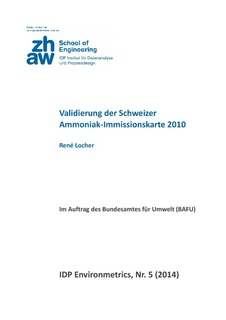Bitte benutzen Sie diese Kennung, um auf die Ressource zu verweisen:
https://doi.org/10.21256/zhaw-125| Publikationstyp: | Working Paper – Gutachten – Studie |
| Titel: | Validierung der Schweizer Ammoniak-Immissionskarte 2010 |
| Autor/-in: | Locher, René |
| DOI: | 10.21256/zhaw-125 |
| Umfang: | 33 |
| Erscheinungsdatum: | 2014 |
| Reihe: | IDP Environmetrics |
| Reihenzählung: | 5 |
| Verlag / Hrsg. Institution: | ZHAW Zürcher Hochschule für Angewandte Wissenschaften |
| Verlag / Hrsg. Institution: | Winterthur |
| ISBN: | 978-3-905745-75-7 |
| Sprache: | Deutsch |
| Schlagwörter: | Immissionskarte; Luftqualität; Robuste Regression; Meteobereinigung; Adjusting for meteorological effects; Air quality; Map of air pollution; Robust regression |
| Fachgebiet (DDC): | 363: Umwelt- und Sicherheitsprobleme |
| Zusammenfassung: | The efficacy of actions taken in order to reduce the ammonia emissions is monitored by measuring ambient concentrations of ammonia. Since 1999, the Federal Office of Environment (FOEN) and the Cantons have been funding a program for measuring ambient ammonia concentrations using passive samplers. Simultaneously, Meteotest has been mandated by FOEN to map periodically the ammonia concentration in Switzerland using physical models.
The aim of this project was to compare the map 2010 of ambient ammonia concentrations with the annual mean values of the meteorologically adjusted measured concentrations of 2010. This task has been carried out in two steps: Statistical model I adjusts the ambient ammonia concentrations for weather conditions. Statistical model II models the systematic deviation of the map value from the corresponding adjusted measured concentration as a function of different local properties: elevation, standard deviation of elevation within a perimeter of 300 meters, original concentration on the map and region. This model was then used to correct the map for these systematic errors. However, choosing measurement locations which are more representative with respect to elevation and region could further improve model II. Immissionsmessungen von Ammoniak sind ein wichtiges Instrument für die Erfolgskontrolle der getroffenen Massnahmen zur Reduktion der Ammoniak-Emissionen. Seit Mitte 1999 finanzieren deshalb das Bundesamt für Umwelt (BAFU) und die Kantone Ammoniak-Messungen mittels Passivsammlern. Gleichzeitig beauftragte das BAFU Meteotest, mittels physikalischen Modellen regelmässig Karten über die Ammoniakkonzentration in der Schweiz zu berechnen. Ziel dieses Projekts war ein Vergleich der Konzentrationen gemäss Ammoniak-Karte 2010 mit den Jahresmitteln 2010 der meteobereinigten Messungen. Die Analyse wurde zweistufig durchgeführt. Das statistische Modell I beschreibt wie die Immissionen von der Witterung abhängen, so dass meteobereinigte Jahresmittelwerte berechnet werden konnten. Im statistischen Modell II wurde anschliessend die systematische Abweichung der Kartenkonzentration vom meteobereinigten Jahresmittelwert der gemessenen Konzentration als Funktion weiterer Einflussgrössen modelliert: Höhe über Meer, Standardabweichung der Höhen im Umkreis von 300m, Kartenkonzentrationen, Region. Mit diesem Modell konnte anschliessend die Karte korrigiert werden. Allerdings würde eine repräsentativere Auswahl der Standorte der Messungen in Bezug auf die Höhe über Meer und der Regionen die statistische Korrektur mittels Modell II noch weiter verbessern. The efficacy of actions taken in order to reduce the ammonia emissions is monitored by measuring ambient concentrations of ammonia. Since 1999, the Federal Office of Environment (FOEN) and the Cantons have been funding a program for measuring ambient ammonia concentrations using passive samplers. Simultaneously, Meteotest has been mandated by FOEN to map periodically the ammonia concentration in Switzerland using physical models. The aim of this project was to compare the map 2010 of ambient ammonia concentrations with the annual mean values of the meteorologically adjusted measured concentrations of 2010. This task has been carried out in two steps: Statistical model I adjusts the ambient ammonia concentrations for weather conditions. Statistical model II models the systematic deviation of the map value from the corresponding adjusted measured concentration as a function of different local properties: elevation, standard deviation of elevation within a perimeter of 300 meters, original concentration on the map and region. This model was then used to correct the map for these systematic errors. However, choosing measurement locations which are more representative with respect to elevation and region could further improve model II. |
| URI: | https://digitalcollection.zhaw.ch/handle/11475/125 |
| Departement: | School of Engineering |
| Organisationseinheit: | Institut für Datenanalyse und Prozessdesign (IDP) |
| Enthalten in den Sammlungen: | IDP Environmetrics |
Dateien zu dieser Ressource:
| Datei | Beschreibung | Größe | Format | |
|---|---|---|---|---|
| 462736221.pdf | 3.44 MB | Adobe PDF |  Öffnen/Anzeigen |
Zur Langanzeige
Locher, R. (2014). Validierung der Schweizer Ammoniak-Immissionskarte 2010. ZHAW Zürcher Hochschule für Angewandte Wissenschaften. https://doi.org/10.21256/zhaw-125
Locher, R. (2014) Validierung der Schweizer Ammoniak-Immissionskarte 2010. Winterthur: ZHAW Zürcher Hochschule für Angewandte Wissenschaften. Available at: https://doi.org/10.21256/zhaw-125.
R. Locher, “Validierung der Schweizer Ammoniak-Immissionskarte 2010,” ZHAW Zürcher Hochschule für Angewandte Wissenschaften, Winterthur, 2014. doi: 10.21256/zhaw-125.
LOCHER, René, 2014. Validierung der Schweizer Ammoniak-Immissionskarte 2010. Winterthur: ZHAW Zürcher Hochschule für Angewandte Wissenschaften
Locher, René. 2014. “Validierung der Schweizer Ammoniak-Immissionskarte 2010.” Winterthur: ZHAW Zürcher Hochschule für Angewandte Wissenschaften. https://doi.org/10.21256/zhaw-125.
Locher, René. Validierung der Schweizer Ammoniak-Immissionskarte 2010. ZHAW Zürcher Hochschule für Angewandte Wissenschaften, 2014, https://doi.org/10.21256/zhaw-125.
Alle Ressourcen in diesem Repository sind urheberrechtlich geschützt, soweit nicht anderweitig angezeigt.